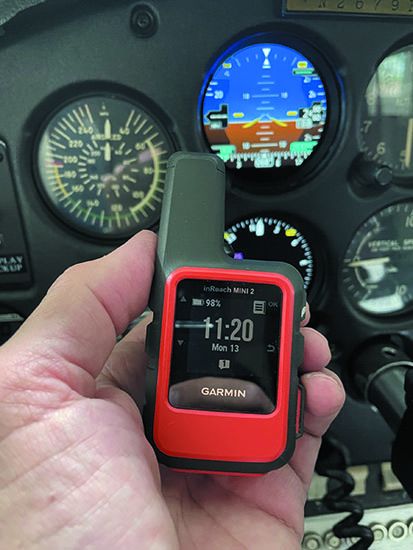In February, Aviation Consumer editor Larry Anglisano asked that I use Garmin’s new inReach Mini 2 for a few months and write up my experience with the unit. I live in rural North Idaho and am often out of reach of cellphone service at backcountry airports, remote lakes and on hikes. When I’m flying in remote areas, I wear a survival vest and keep a personal locator beacon (PLB) in one of the pockets.
The Mini 2 is a seriously sophisticated satellite communication device with the ability to send and receive texts, track movement (and send the tracking information) as we’ll as get weather and navigate. It’s priced at $399.99. There is a $29.95 initial activation fee and the user selects one of three usage plans that range from $11.95 to $49.95 per month.
All plans include the SOS “I need help, here, now” feature. The differences between plans are primarily the tracking interval, cost of sending tracking points, cost of sending and receiving texts and getting weather information.
SETUP
Once I received the Mini 2, I spent 90 minutes getting it set up. It wasn’t difficult, just time-consuming.
I used the Mini 2 on some long flights over the Western Rockies between the north end of Idaho and southern Colorado—twice crossing the Continental Divide.
I used the tracking feature and made sure that the Mini 2 could “see” the sky by Velcroing its carabiner to the A pillar of the Cessna 182 I was flying. That also kept the unit in clear view when I was getting out of the airplane so that I remembered to take it with me when I got out. There was a downside to its small size—I constantly misplaced it.
I greatly appreciated the tracking feature. I let a couple of people know when I was going flying in remote areas. They’d check the track. If it stopped and I didn’t send a text message saying that all is well, they would call and get a search started in the right area.
I did not use the text function other than to advise people that I was starting or ending a flight. If I were staying for a while in the backcountry, I might use it more often.
Bottom line is that a Mini 2 is not a PLB that I can put in my survival vest and forget until I need it. I will always have a PLB in the airplane. A good one costs under $400 and lasts six to nine years. That’s less inexpensive insurance.
I’m uncomfortable having to have a paid-up subscription to be rescued—a subscription requirement is why a satellite communicator is not a PLB. While Garmin has flexible plans, I’d not want to try to save money by shutting off and turning on the various service plans for fear that the great cosmic joke would be that I’d need to send an SOS and I’d forgotten to activate the service or hadn’t recharged the battery. Accordingly, the “recreation” plan, the mid-level one—the one that I’d select—costs $300 a year. So, is a Mini 2 worth the cost of admission and subscription after buying a PLB?
Frankly, after three months of using the Mini 2, I like its light weight and the ability to communicate wherever I am, especially if I’ve got a problem that doesn’t rise to the level of an emergency. I also like letting selected people see my track. So, if I’m going to regularly be flying in the backcountry, I consider the Mini 2 to be an affordable luxury.


